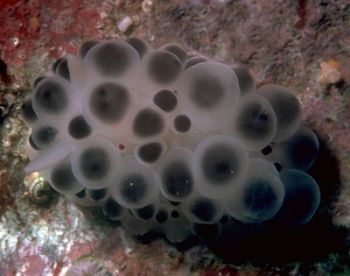
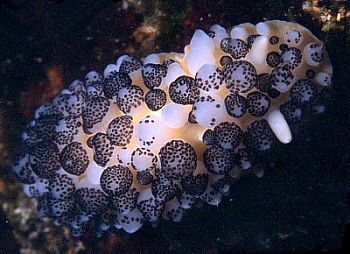
Ceratophyllidia spp.
Order: NUDIBRANCHIA
Suborder: DORIDINA
Family: Phyllidiidae
DISTRIBUTION
Species of Ceratophyllidia are found throughout the tropical Indo-West Pacific.
PHOTO
UPPER: Brunckhorst's Ceratophyllidia sp. 2 - Kwajalein Atoll, Marshall Ids., 15m, June 1983. Photo: Scott Johnson (from Brunckhorst, 1993: Plate 9F).
LOWER: C. africana - Park Rynie, south coast KwaZulu-Natal, South Africa, 30 m, November 2001, Length: 40 mm. Photo: Valda Fraser.
This remarkable genus of phyllidiids has large spherical dorsal tubercles scattered over its otherwise smooth dorsum. Brunckhorst, 1993 considers that the only named species, C. africana, is restricted to the western Indian Ocean and suggests Western Pacific species can be separated into two further species. His main distinguishing features (Brunckhorst, 1993) are the presence or absence of dark markings on the dorsum and whether the spherical tubercles are a uniform dark colour (grey or brownish - in Pacific species), or with black spots (in C. africana). I have seen specimens of both colour forms from New Caledonia so it is possible that Ceratophyllidia africana is a widely distributed species with a variable colour pattern. The spherical tubercles on the back of Ceratophyllidia are attached by a short narrow "stalk". When disturbed the animal is able to break off the tubercles so often animals can be found with a mixture of large and small (growing) tubercles which are replacing ones which have been broken off. Specimens in collections often have only a few or no tubercles.
I am putting all animals that appear to be Ceratophyllidia together on one page until we have a better way of distinguishing species.
Compare Ceratophyllidia with Phyllidiopsis cardinalis.
Reference:
• Brunckhorst, D.J. (1993) The systematics and phylogeny of Phyllidiid Nudibranchs (Doridoidea). Records of the Australian Museum, Supplement 16: 1-107.
Rudman, W.B., 1998 (July 23) Ceratophyllidia spp. [In] Sea Slug Forum. Australian Museum, Sydney. Available from http://www.seaslugforum.net/find/ceratop1
Related messages
Okinawan Ceratophyllidia
November 24, 2001
From: Bob Bolland
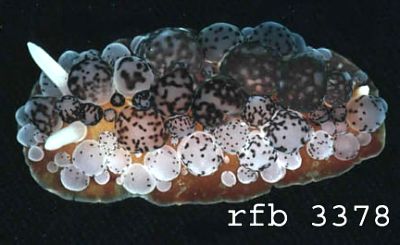
Hi Bill,
Here is a photo of an Okinawan Ceratophyllidia (africana?) which is very similar to both Valda's recent post of a Ceratophyllidia africana in the Forum and that is seen in Terry's Nudibranchs of South Africa.
The animal was found crawling on the surface of a small patch of open sand in an area of strewn coral rubble. This is the only one I've seen here and it has been deposited with the Calif. Acad. Sciences. Quite a range extension if this is C. africana.
Data: RFB # 3378., TL: 32mm., Collection Depth: 50m (165ft)., Seragaki, Okinawa, 15 March 1995.
Reference:
Gosliner, T. 1987. Nudibranchs of Southern Africa. A Guide to Opisthobranch Molluscs of Southern Africa. Sea Challengers, Monterey, California.
Cheers,
Bob
bollandr@rapid-link.ne.jp
Bolland, R.F., 2001 (Nov 24) Okinawan Ceratophyllidia. [Message in] Sea Slug Forum. Australian Museum, Sydney. Available from http://www.seaslugforum.net/find/5718Dear Bob,
Another interesting find. Its background yellow colour looks like Valda's South African photo and the change in colour of the cerata is identical to that seen in Walabha's photo of a 'green' animal from Indonesia.
Best wishes,
Bill Rudman
Ceratophyllidia africana from South Africa
November 23, 2001
From: Valda Fraser


Dear Bill
Over the weekend I found Ceratophyllidia africana. Have seen that it was described by Eliot from Tanzania with reference to a single specimen. Gosliner also found an animal at Sodwana, north coast KwaZulu-Natal.
Hope you like it!
Locality: Park Rynie, south coast KwaZulu-Natal, South Africa, 30 m
Date: November 2001
Size: 40 mm
Regards
Valda
valdafraser@mweb.co.za
Fraser, V., 2001 (Nov 23) Ceratophyllidia africana from South Africa. [Message in] Sea Slug Forum. Australian Museum, Sydney. Available from http://www.seaslugforum.net/find/5704Thanks Valda,
It is interesting to compare this South African animal with Walabha's animal from Indonesia, which has a green mantle and outer tubercles which are white with black spots, like yours, but has inner tubercles which are black with white spots. As I say at the top of the page, we have so few records of animals in this genus that it is not possible to interpret the significance of the colour differences at present.
Best wishes,
Bill Rudman
Ceratophyllidia? from Indonesia & Thailand
October 8, 2001
From: Walabha Sinbul
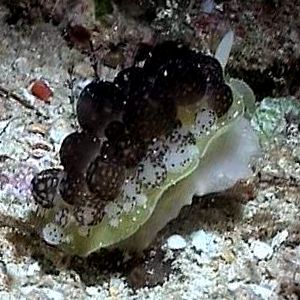
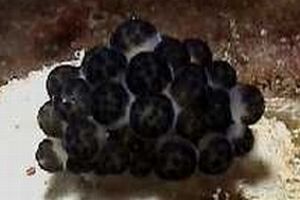
Dear Bill,
How are you doing? Hope all is well with you. Here I am again, an amateur diver from Thailand, writing another mail to ask you to illuminate me on this nudibranch I've found lately [Upper right photo}. I spotted this fellow on the sandy bottom at the dive site called Sea Coral Garden 1, Derawan, Indonesia on the afternoon of August 15 [2001]. The approximate depth was 18 metres. There was another one of this kind with it. Nearby we found their egg mass. The color was white.
My friend and I are certain that we've never seen this fellow before and once again that we looked at each other and agreed to, "Ask Bill". So could you please help identify him for us and if possible, please also give me a link where I could find more information about him?
I have also sent a picture [Lower right] of what we think is the same kind that we've just encountered from our PhiPhi Island, Krabi, Thailand. It was the size of my thumbnail and was totally alone on a vast landscape of sheer coral rubbles.
Thank you very much indeed Bill.
Cheers,
Walabha
walabha@hotmail.com
Sinbul, W., 2001 (Oct 8) Ceratophyllidia? from Indonesia & Thailand. [Message in] Sea Slug Forum. Australian Museum, Sydney. Available from http://www.seaslugforum.net/find/5128Dear Walabha,
Thanks for the interesting photos. The Phi Phi island animal is definitely a species of Ceratophyllidia but at present the experts don't know if there is just one species or a number. basically we don't know enough about them. Your animal from Indonesia looks quite like a sacoglossan sea slug like Cyerce. [See ] but it could just as well be a Ceratophyllidia. I don't know of any that have been reported to have green colouration. The edge of the mantle and the foot seem more like a dorid than a sacoglossan but I would need to have a better look at its head to be sure. Until I have more information I will leave it with Ceratophyllidia.
Ceratophyllidia, despite the large 'cerata-like' tubercles on its back, is a phyllidiid nudibranch, closely related to Phyllidia, Reticulidia, Phyllidiella and related genera.
Best wishes,
Bill Rudman.
Ceratophyllidia sp. from Japan
October 2, 2001
From: Nishina Masayoshi
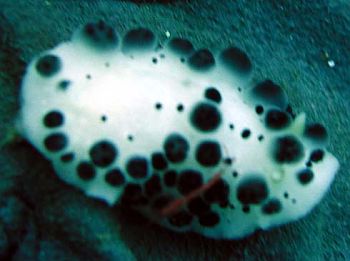
Dear Dr.Rudman,
First, I must apologize to this animal and people who love sea slugs. I did not recognize this animal as being a kind of sea slug. I thought it is a kind of soft coral but my wife knew and pointed it out to me. It was to the rock wall.
I touched the surface comparatively strongly and cerata fell out. And it was then that I realized for the first time that this animal is a sea slug. Although it's not a good photo I hope it is useful in your study.
Data
Hachijo Island, 21 April 2001
Depth:8m
Lenght:30mm
Frequency on Hachijo: maybe uncommon or rare
Best Regards,
Nishina Masayoshi
nishina@hpe15.wips.co.jp
Nishina, M., 2001 (Oct 2) Ceratophyllidia sp. from Japan. [Message in] Sea Slug Forum. Australian Museum, Sydney. Available from http://www.seaslugforum.net/find/5059Dear Nishina,
Thanks for the photo. It is a good photo to have because it shows very well how these animals drop their tubercles so easily
Best wishes,
Bill Rudman
Comparing Ceratophyllidia
July 23, 1998
From: Bill Rudman

PHOTO: Kwajalein Atoll, Marshall Ids., 15m, June 1983. Photo: Scott Johnson (from Brunckhorst, 1993: Plate 9F).
I have added this picture of Ceratophyllidia for comparison with Phyllidiopsis cardinalis. This remarkable phyllidiid has large spherical dorsal tubercles, scattered over its otherwise smooth dorsum. Brunckhorst, 1993 considers that the only named species, C. africana, is restricted to the western Indian Ocean and suggests Western Pacific species can be separated into two further species. His main distinguishing features (Brunckhorst, 1993) are the presence or absence of dark markings on the dorsum and whether the spherical tubercles are a uniform dark colour (grey or brownish - in Pacific species), or with black spots (in C. africana). I have seen specimens of both colour forms from New Caledonia so it is possible that Ceratophyllidia africana is a widely distributed species with a variable colour pattern. The spherical tubercles on the back of Ceratophyllidia are attached by a short narrow "stalk". When disturbed the animal is able to break off the tubercles so often animals can be found with a mixture of large and small (growing) tubercles which are replacing ones which have been broken off. Specimens in collections often have only a few or no tubercles.
Bill Rudman.
